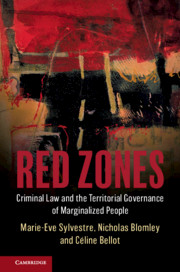Book contents
- Red Zones
- Red Zones
- Copyright page
- Dedication
- Contents
- Figures
- Maps
- Tables
- Acknowledgments
- Cases
- Legislation
- 1 Navigating the Territories of the Law
- Part I Foundations
- 2 Law and Territory: A Legal Geography
- 3 “Recognizances to Keep the Peace and Be of Good Behaviour”: The Legal History of Red Zones and Conditions of Release
- Part II Expansion
- Part III Territorialization and Its Consequences
- Conclusion
- Bibliography
- Index
3 - “Recognizances to Keep the Peace and Be of Good Behaviour”: The Legal History of Red Zones and Conditions of Release
from Part I - Foundations
Published online by Cambridge University Press: 06 February 2020
- Red Zones
- Red Zones
- Copyright page
- Dedication
- Contents
- Figures
- Maps
- Tables
- Acknowledgments
- Cases
- Legislation
- 1 Navigating the Territories of the Law
- Part I Foundations
- 2 Law and Territory: A Legal Geography
- 3 “Recognizances to Keep the Peace and Be of Good Behaviour”: The Legal History of Red Zones and Conditions of Release
- Part II Expansion
- Part III Territorialization and Its Consequences
- Conclusion
- Bibliography
- Index
Summary
Chapter 3 delves into the historical context surrounding the ancient practices of bail and the origins of probation, as well as contemporary developments in Canada, the U.S.A. and the U.K. It goes back to the “antiquities of bail” (De Haas, 1940) and the origins of probation in order to contextualize and understand better the legal framework that governs them today. In particular, it traces the history of judicially imposed conditions of release, trying to identify how and when they came to be included in bail and sentencing practices. In order to trace the origins of conditions of release and of their intricate connection with the regulation of the poor, one has to follow the history of another important instrument of law enforcement, namely recognizances to keep the peace and peace bonds. This chapter ultimately shows how legal actors have throughout the history of English common law used the criminal process to create and enforce territories, directly governing people’s uses of spaces.
Keywords
- Type
- Chapter
- Information
- Red ZonesCriminal Law and the Territorial Governance of Marginalized People, pp. 38 - 56Publisher: Cambridge University PressPrint publication year: 2020



